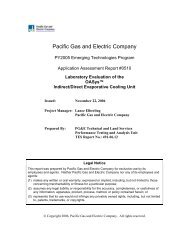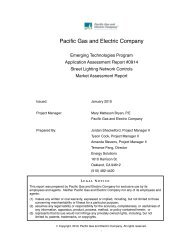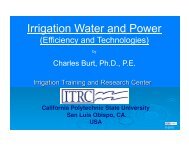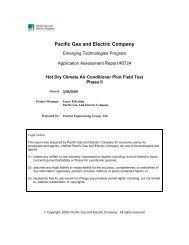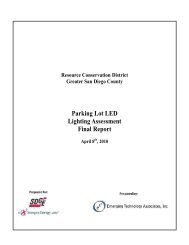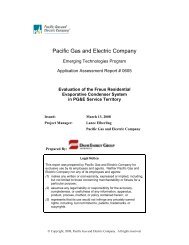High Efficiency Office: Low Ambient/ Task Lighting Pilot Project
High Efficiency Office: Low Ambient/ Task Lighting Pilot Project
High Efficiency Office: Low Ambient/ Task Lighting Pilot Project
Create successful ePaper yourself
Turn your PDF publications into a flip-book with our unique Google optimized e-Paper software.
Heschong Mahone Group, Inc.<br />
Pacific Gas and Electric Company<br />
Emerging Technology <strong>Low</strong> <strong>Ambient</strong>/<strong>Task</strong> <strong>Lighting</strong> <strong>Pilot</strong>s<br />
APPENDIX D—DETAILS OF COST-EFFECTIVENESS CALCULATIONS<br />
Figure 20 shows all the figures used in the cost-effectiveness calculations. Further<br />
explanation of the sources of the data and the calculations used are given in the sections<br />
below the table. Note that the savings and payback period do not include any additional<br />
savings from reducing the building’s cooling load, which would add approximately 20%<br />
to the lighting savings 1 .<br />
Energy use (kWh/sf/yr)<br />
Peak load (W/sf)<br />
Installed lighting power density (W/sf)<br />
Energy savings relative to a typical T24<br />
compliant system (kWh/sf/yr)<br />
Cost savings relative to a typical T24<br />
compliant system at $0.18/kWh ($/sf/yr)<br />
Incremental task lighting cost relative to a<br />
similar T24 compliant system ($/sf)<br />
Reduced overhead lighting cost relative to a<br />
similar T24 compliant system ($/sf)<br />
Total incremental cost of low ambient system<br />
relative to similar T24 compliant system<br />
Simple payback relative to similar T24<br />
compliant system<br />
Title 24 2008<br />
3.9 (estimated 2 ) 5.7<br />
0.97 (estimated) 1.42<br />
1.21 (max allowed in<br />
this space under T24)<br />
Figure 20. Details of Cost-Effectiveness Calculations<br />
1 Rundquist, R.A. ; Johnson, K.F. ; Aumann, D.J, Calculating lighting and HVAC interactions, ASHRAE Journal<br />
(American Society of Heating, Refrigerating and Air-Conditioning Engineers); (United States); Journal Volume:<br />
35:11, and Osman Sezgen and Jonathan G. Koomey, Interactions Between <strong>Lighting</strong> And Space Conditioning Energy<br />
Use In U.S. Commercial Buildings, LBNL report number 39795.<br />
2 This calculation assumes that the Title 24 installation would use less power than the existing lighting installation in<br />
proportion with its reduced power density, i.e. by a factor of 1.21/1.78. A conservative 10% multiplier is included<br />
for A/C savings. Note that the projected savings of $0.22/sf/yr is much less than the $0.49/sf/yr saved at the Encon<br />
building, because a large part of the savings at Encon were due to improved controls switching off the lights outside<br />
business hours<br />
25<br />
0<br />
0<br />
0<br />
0<br />
0<br />
N/A<br />
Existing<br />
lighting<br />
1.78<br />
-1.8<br />
-$0.32<br />
N/A<br />
N/A<br />
N/A<br />
N/A<br />
<strong>Low</strong> <strong>Ambient</strong><br />
lighting<br />
2.0<br />
0.73<br />
0.65<br />
1.9<br />
$0.34<br />
Equipment $2.14<br />
Labor $0.13<br />
TOTAL $2.27<br />
$0.31<br />
$1.96<br />
5.8 years



